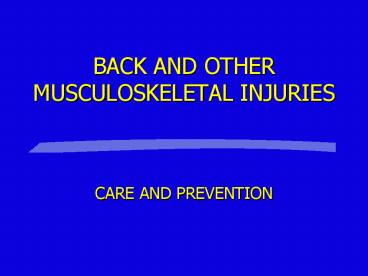BACK AND OTHER MUSCULOSKELETAL INJURIES - PowerPoint PPT Presentation
1 / 26
Title:
BACK AND OTHER MUSCULOSKELETAL INJURIES
Description:
Tighten abdominal muscles to support your spine. Get a good grip- use both hands ... Exercise Program. Design and carry out exercise protocol to fit body needs ... – PowerPoint PPT presentation
Number of Views:79
Avg rating:3.0/5.0
Title: BACK AND OTHER MUSCULOSKELETAL INJURIES
1
BACK AND OTHER MUSCULOSKELETAL INJURIES
- CARE AND PREVENTION
2
STATISTICS
- Almost 100 will suffer some musculoskeletal
problem in their lifetime - 80 of work-age persons have already experienced
some back pain or discomfort - 100 million work days lost annually
- Direct and indirect dollars spent annually is
over 25 BILLION dollars - Back injuries second only to respiratory
infections in lost work time and dollars
3
THE SKELETONSBASIC FUNCTIONS
- Provides body support
- Maintain upright position
- Protect spinal cord and other soft tissue
- Allows flexibility to bend and rotate
- Cushion against shock
4
CAUSES OF MUSCULOSKELETAL INJURY CAUSES
- Probably no single cause
- Result of years of traumas and stresses
- Eventual twinge or pop is the straw that
broke the camels back - Collective causes are poor posture, faulty body
mechanics, loss of body strength and flexibility,
and general fitness decay
5
GENERAL STRESSERS
- Slouched posture (leads to Kyphosis)
- Improper lifting and carrying
- Repetitive motion
- Poor sleeping, sitting, and standing posture
- Muscle Guarding and Spasms
6
ANATOMY OF THE VERTEBRAL COLUMN
- Vertebra - Bones
- Process - Bone extension from vertebra
- Joint - Space between vertebra
- Disc - Cartilage rings or pads
- Ligament - Connective tissue
- Muscle - Create movement
- Tendon - Tie muscles to bones
- Nerve - Control muscle activity
7
PHYSIOLOGY OF THE VERTEBRAL COLUMN
- Provides body support and structure
- Absorbs shock
- Enervation path to most all body parts
- No blood flow or enervation to discs
- Discs cannot be repaired or replaced by body
- Pain in extremities may be caused by pinched
nerve in vertebral column
8
Vertebral Column Regions
Cervical (7)
Thoracic (12)
Lumbar (5)
Sacral (5)
9
STANDING POSTURE
- Keep your spinal column aligned in its natural
curves - To reduce stress on lower back rest one foot at a
time - Keep work area at elbow level
10
STRETCH OFTEN SHIFT POSITIONS
- Change (shift) your posture often
- Stretch frequently
- Keep your body flexible (not rigid or fixed)
- Dont force your body to conform to its workspace
11
PREPARING TO LIFT OR MOVE
- Stretch your muscles and warm up before lifting?
- Wear slip resistant shoes?
- Clear a pathway before you move the item?
- Visualize the move before you start.
12
LIFT WITH COMMON SENSE!
- Assess the situation
- Is the load big, bulky, heavy?
- Do you need help?
- Remember, no single technique will work in all
circumstances
13
PUSH-- DONT PULL
- Can You Slide It Instead of Lift It?
14
Need Help Or Assistance?
- If needed, get help or assistance before lifting
- Use proper equipment
- - Hand trucks
- - Forklifts
- - Dollies or carts
- Re-adjust the load or your position before you
lift
15
The Safe Lifting Zone
- The safe lifting zone is between the knees and
shoulders - Below knee level? Bend with your knees and lift
with your legs - Above your shoulders? Use a stool or ladder
16
When You Lift ---
- Plant your feet firmly - get a stable base
- Bend the knees- not the waist
- Tighten abdominal muscles to support your spine
- Get a good grip- use both hands
- Place hands on opposite corners for balance
17
When You Lift ---
- Keep the load close to your body
- Use your leg muscles as you lift
- Keep your back upright, in its natural posture
- Lift steadily and smoothly without jerking
18
When You LiftDo Not!
- Lift while reaching or stretching
- Lift from an uncomfortable posture
- Fight to recover a dropped object
- Lift and twist at the same time
19
Lifting And Carrying Problems
- Loss of Body Balance
- Deviating from the backs normal curvature
- Sideward lifting
- Extended arms lifting
- Improper carrying
- Twisting and repetitive motion
20
Common Mistakes
- Lifting with back bent forward and legs straight
- Using fast jerky motions
- Lifting and twisting at the same time
- Carrying the load away from the body
- Poor planning and/or communication
- Insufficient strength
21
Rules For Lifting
- Plan lifts Remove obstacles
- Test the load weight
- Get assistance when necessary
- Maintain balanced body position
- Whenever possible use large muscles
- Firm stomach muscles when lifting
- Proper hand placement for balance
22
Rules For Lifting
- Keep load as close to the body as possible
- Pivot feet instead of twisting back
- Minimize reaching and bending
- Smooth and continuous motions
- Maintain wide stable base throughout lift
23
Examples Of Injuries And Maladies
- Herniated or ruptured disc. No such thing as a
slipped disc - Osteoarthritis - a wearing away of discs
- Aging and weight lifting causes a flattening of
discs - Accidental injury (breaks, sprains, strains,
etc.) - Birth defects
24
Exercise Program
- Design and carry out exercise protocol to fit
body needs - Utilize stretch routine frequently to keep body
flexible - Helps prevent injury
- Do not overdo-- follow doctors instruction
carefully
25
Muscle Guarding
Pain
Muscle Inflammation
Muscle Guarding
Muscle Spasm
Restricted Movement
Circulatory Reduction
Metabolite Retention
26
Remember!
- Plan your tasks carefully to avoid back pain or
stress - Managing your back is your responsibility
- Your work day is one third of your total day
- Relieving musculoskeletal stress away from work
is just as important
27
(No Transcript)































